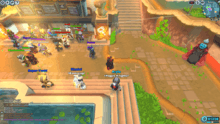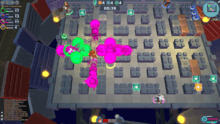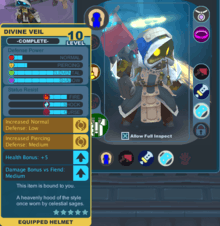Spiral Knights
| Spiral Knights | |
|---|---|
 | |
| Developer(s) | Three Rings Design |
| Publisher(s) | Sega |
| Composer(s) | Harry Mack[1] |
| Platform(s) | Any with Java, incl. Linux, Mac, Windows |
| Release date(s) | November 12, 2009 |
| Genre(s) | MMORPG |
| Mode(s) | Multiplayer/Solo (mission only) |
| Distribution | Download/Browser, Steam |
Spiral Knights is a massively multiplayer online role-playing game created by Three Rings Design and published by Sega. The free-to-play, Java-based game was released to advance testers on November 12, 2009[2] and to the general public on April 4, 2011.[3] The game was released through the Steam software distribution system on June 14 of that year,[4][5] and through Kongregate on September 22.
In the game, the player controls a knight of the Spiral Knights order, which has crash-landed on the mysterious planet Cradle. Knights collectively explore the Clockworks, the mechanized, constantly reorganizing dungeon that fills the planet's interior. The knights equip armor and weapons to aid them in their battles against the monsters inhabiting the Clockworks. When they are not exploring, knights trade with each other and with vendors, in order to improve their equipment.
World

When a player creates a knight, he or she first proceeds through a few tutorial levels, learning the game's basic controls. Through talking with non-player characters, players learn about the plot and the economy of the game world. Once a knight leaves the tutorial levels by traveling to Haven, the knight may never return to them.
Haven is the largest city on Cradle and the base of operations for the Spiral Knights (see image at right). The Town Square contains the Auction House, through which knights may sell items to each other. The Bazaar contains various vendors who sell equipment. The Arcade contains the gates, through which players enter the Clockworks. Other areas in and around Haven include the guild halls, the Advanced Training Hall, and King Krogmo's Coliseum.

The Clockworks is the enormous dungeon that fills the interior of the planet Cradle. It is organized into 30 levels (depths 0 to 29), which are further organized into six strata constituting three tiers. The strata are punctuated by terminals and towns, at which the knight may shop for equipment, adjust equipment, and heal. The Clockworks is in fact an enormous machine, and the contents of the strata are continually shifting. A knight can usually, but not always, determine the nature of upcoming levels by consulting the gate map (see image at left).
At predictable locations within the Clockworks, four bosses can be found: the Snarbolax,[6] the Royal Jelly, the Roarmulus Twins,[7] and Lord Vanaduke. Knights who defeat these bosses are rewarded with tokens, which they can redeem for special items.
On the 19th of October, 2011, Shadow lairs were introduced. These were the aforementioned bosses infected by 'The Swarm', a pixelized black substance, about which relatively nothing is known. It is expected that new missions be released in the future concerning 'the Swarm'.[8]
Gameplay
Spiral Knights is a top-down, third-person, real-time action-adventure game, comparable to The Legend of Zelda: Four Swords Adventures.[9] While thousands of knights may be participating in Spiral Knights at a time, any given knight interacts directly with only a small subset of them. For example, in Haven there are typically tens of knights present; however, there are tens of independent copies of Haven being maintained simultaneously. When a knight is in the Clockworks, he interacts with only three (or fewer) other knights, as well as numerous monsters.
When a party of knights begins a Clockworks level, they appear together at an entry point. Their goal is to make it to the elevator, which allows them to descend to the next level or to return to Haven. The knights' route through the level is controlled, to some extent, by a sequence of gates. For example, one kind of gate opens only when the entire party stands together on a platform in front of it; when the gate opens, another gate immediately closes behind the party, sealing off the route from which they came. There are also switches to activate, keys to retrieve, and traps to avoid.
While they proceed through the level, the knights battle monsters together in real time. A knight may wear three pieces of armor (suit, helmet, and shield) and up to two trinkets (items that grant additional protection or enhancement) at a time. Also, a knight may wield up to four weapons at a time, by choosing from among whatever swords, handguns, and bombs he possesses. There are four kinds of damage, that a knight can inflict upon a monster, depending on the weapon he uses: normal, piercing, elemental, and shadow. Each monster type is vulnerable, neutral, and resistant to certain damage types. Additionally, there are seven status effects that a knight can inflict upon a monster: freeze, shock, curse, fire, sleep, poison, and stun. Status effects do not directly damage the monster, but do affect its ability to continue fighting. Symmetrically, monsters deal certain kinds of damage and status effects to knights, who resist them to varying degrees based on their armor. Occasionally, knights find objects that temporarily bolster their defenses, that partially heal their damage, or that they can throw at monsters to inflict damage and induce status effects.
The knights collect treasure dropped by the monsters and extracted from treasure chests. They also collect minerals, which can be applied to the construction of new gates in the Arcade. Significantly, most of the items picked up by the party during its travels are shared. In this way, the rules of the game promote teamwork rather than competition among players. Knights help each other by ganging up on monsters, by healing each other, etc. However, some items are not shared, and some players prefer to play Spiral Knights solo.

On August 2, 2011, a player-versus-player feature was added, in which knights enter contests against each other, with a chance of winning prizes.[10] The first of these contests, called Blast Network, is similar to Bomberman; players place bombs to destroy blocks and their opponents while collecting power-ups. The second contest, called Lockdown, employs gameplay similar to that of the rest of Spiral Knights. Each team of knights attempts to capture and defend control points from the opposing team. Each knight's usual shield is replaced with one of three special abilities: speed, invisibility, or strong defense.[11]
On February 22, 2012, a system of missions was introduced. "Missions range from simple tasks like speaking with an NPC to going on a major expedition." Missions reward the knight with rank, prestige, and items.[12]
There have been some changes in the game like the user interface system has been changed and some functions like bash and dash have also been added. An option to customize controls was also added. As of July 30, 2013, a pet feature was added called "Battle Sprites."
Economy

Spiral Knights differs from some other role-playing games in that the characters do not possess personal characteristics (e.g., experience levels, hit points) that improve over time. Rather, only a character's equipment improves over time. Namely, each knight begins the game with a set of 0-star equipment, and gradually acquires better equipment as they works toward 5-star items.
Items can be purchased from vendors and from other players. If an item is bound to a knight, then the knight is unable to trade it. Some items are bound to the knight when he acquires them, while others are bound only when he first equips them. Items can be unbound for a large fee.
Items are often made, rather than purchased, in a process known as crafting. In order to craft an item, a knight must possess a recipe, the set of materials specified by the recipe, and the precursor item (if any). Recipes can be bought from vendors in the Clockworks and in Haven, and from other players. Materials are found while adventuring in the Clockworks, and can be purchased from other players and sometimes from vendors. Some materials are rare and hence expensive. Before a knight uses a recipe to craft an item, he must learn the recipe, and a learned recipe cannot subsequently be traded or unlearned.
As a piece of equipment is used, it slowly accumulates heat. Higher heat levels bring small bonuses to the item's performance, and allow the item to be crafted to a higher-star version. Items are further differentiated by unique variants, which are special bonuses that sometimes randomly attach to items when they are crafted. The screenshot at the right, for example, shows a Divine Veil helmet with an "Increased Normal Defense: Low" unique variant. This Divine Veil protects slightly better against Normal damage, than do Divine Veils without this unique variant.
The in-game currency is the crown. Knights acquire crowns by killing monsters, opening treasure chests in the Clockworks, and trading with other knights. Crowns are used to purchase items, to craft items, to purchase unique variants for items, and to participate in player-vs.-player contests.[13] Each player account can also possess any quantity of crystal energy. An organized trading system in the game lets players exchange crowns for crystal energy at rates that fluctuate with demand. Players can also purchase crystal energy using US dollars.
Social aspects
Spiral Knights is designed to be primarily a cooperative, rather than a competitive, game. Knights explore the Clockworks with up to three other knights. Most items that the party picks up are shared among its members.
Knights communicate through an in-game text chat system. There is also a mail system, which can be used for sending items, crowns, etc., for sending messages to off-line knights, for receiving items and crowns from the Auction House, and for receiving announcements from the game developers.
Each knight maintains a list of friends. The knight can see which of his friends are on-line, and can see where his on-line friends are located within the world. He can invite his friends to join him for adventure, trading, or talking.
A knight may optionally belong to a guild. The knight maintains a list of guildmates, with the same capabilities as his friends list. Additionally, the guild has a private chat channel and a private guild hall where members may gather. Each guild member possesses a rank within the guild, with higher ranks enjoying greater privileges and powers. Any player may start his own guild by paying a fee.[14]
Reception
Reception of Spiral Knights was positive. Ars Technica's Andrew Webster wrote, "The quality of free-to-play games continues to rise, and Spiral Knights is proof of this. It's fun, addictive..."[15] Tony Sims wrote for Wired, "It is very fun and addictive, however hardcore gamers might find it too old-school."[16] Some reviewers have felt that the energy system is too restrictive. Tom Senior of PC Gamer wrote, "When an energy drought stops play halfway through a session with friends, it’s like being poked in the eye."[17] Note: This game now has completely free game sessions. Energy is now only used for activating turrets and 'Mecha Knights,' opening gates, and buying things from an energy depot, so the reviews might be obsolete.
The game was nominated for the 2011 Game Developers Choice Online Awards in four categories: Best Visual Online Arts, Best Online Game Design, Best Audio for an Online Game, and Best New Online Game. It won the award for Best Online Game Design.[18]
Spiral Knights reached one million accounts by July 6, 2011. — three months after launch.[19] The game reached three million accounts by May 17, 2012.[19]
References
- ↑ http://www.amazon.com/gp/product/B005J49Y2C/
- ↑ unknown. "Spiral Knights Database". Retrieved 17 May 2011.
- ↑ Three Rings Design (2011-04-04). "Spiral Knights has officially launched!". Retrieved 2011-08-21.
- ↑ Three Rings Design (2011-06-14). "Binding existing Spiral Knights accounts to Steam accounts". Retrieved 2011-08-21.
- ↑ Three Rings Design (2011-06-15). "Celebrate our Steam Launch with Free Energy!". Retrieved 2011-08-21.
- ↑ Three Rings Design (2011-06-02). "Roar of the Snarbolax". Retrieved 2011-08-21.
- ↑ Three Rings Design (2011-07-06). "Built to Destroy!". Retrieved 2011-08-21.
- ↑ Equinox. "Release Notes 2011-10-19". Retrieved 19 October 2011.
- ↑ Kotaku. "Behold the Zelda-riffic Joy of Spiral Knights". Retrieved 27 April 2011.
- ↑ Three Rings Design (2011-08-02). "King Krogmo's Coliseum and the Blast Network Blowout!". Retrieved 2011-08-21.
- ↑ Three Rings Design (2011-09-14). "King Krogmo Launches Lockdown!". Retrieved 2011-10-28.
- ↑ Three Rings. "Patch Notes - February 22, 2012". Retrieved 29 October 2012.
- ↑ Three Rings. "Spiral Knights Wiki - Energy". Retrieved 27 April 2011.
- ↑ Three Rings. "Spiral Knights Wiki - Guild". Retrieved 26 May 2011.
- ↑ Andrew Webster (Ars Technica) (April 2011). "Addictive but accessible: free-to-play, co-op RPG Spiral Knights". Retrieved 2011-08-21.
- ↑ Tony Sims (Wired) (2011-05-06). "Spiral Knights Online RPG". Retrieved 2011-08-21.
- ↑ Tom Senior (PC Gamer) (2011-07-26). "Spiral Knights review". Retrieved 2011-08-21.
- ↑ Game Developers Choice Online Awards (2011-10-12). "The Second Annual Game Developers Choice Online Awards". Retrieved 2011-10-28.
- ↑ 19.0 19.1 SEGA (July 6, 2011). "SEGA and Three Rings Celebrate One Million Spiral Knights". Retrieved 2011-08-29.